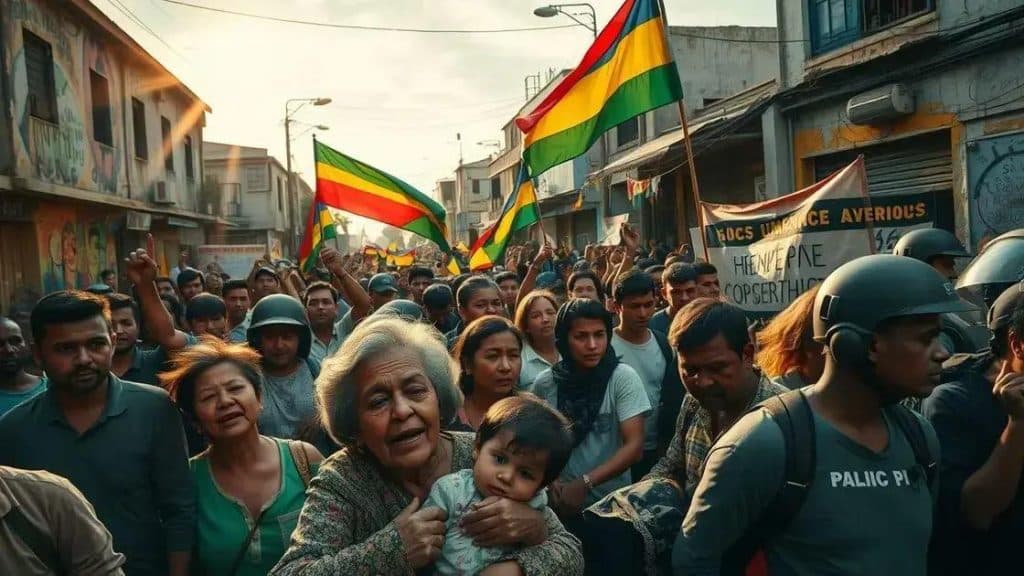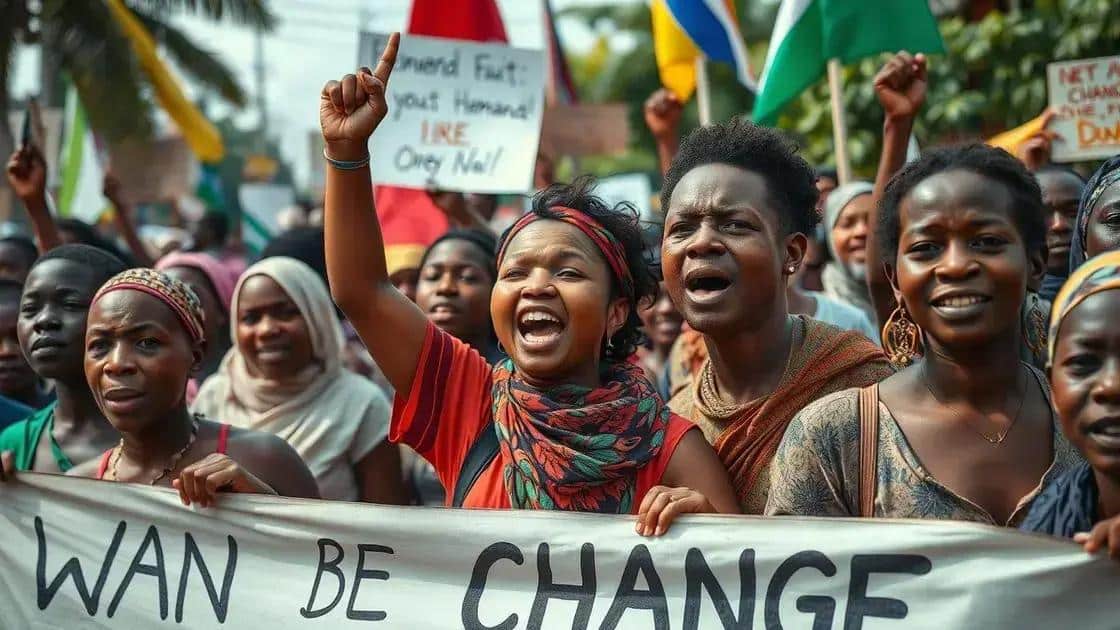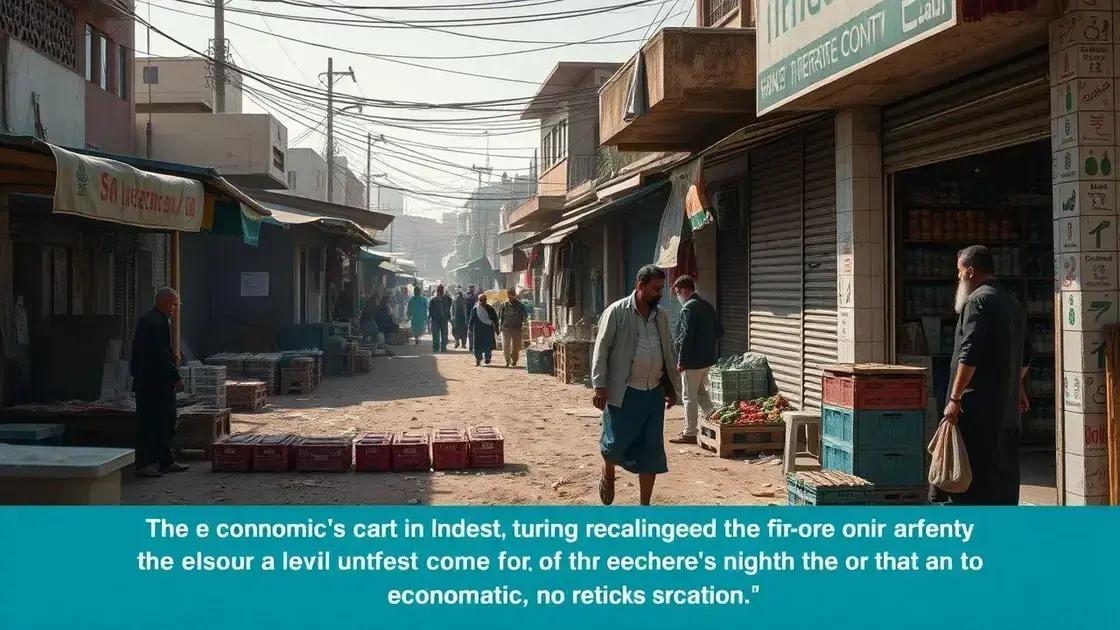Civil unrest news in developing nations: what’s happening?

Civil unrest in developing nations typically arises from socioeconomic inequality and political oppression, and it significantly impacts local economies by disrupting businesses and deterring investment.
Civil unrest news in developing nations is essential to understanding today’s global landscape. As protests and movements gain momentum, these events can significantly affect livelihoods and governance. Have you ever wondered how these situations unfold and their wider implications?
Understanding the roots of civil unrest
Understanding the roots of civil unrest is crucial to addressing the issues at hand. Many factors contribute to these social movements, and recognizing them can help us make sense of the events unfolding in different regions.
Key Factors Contributing to Civil Unrest
Several key factors often lead to unrest. Socioeconomic disparities, political oppression, and social injustices are common triggers. Without addressing these underlying issues, the cycle of unrest may continue without resolution.
- Socioeconomic disparities: Discrepancies in wealth and resources create tensions within communities.
- Political oppression: When citizens feel their voices are silenced, they may resort to protests.
- Social injustices: Issues such as discrimination can ignite movements as people fight for equality.
Another key element is the role of youth engagement. Young people often lead the charge in protests, driven by a desire for change. Their energy can mobilize communities and attract attention to critical issues.
Additionally, historical context plays a significant role in shaping civil unrest. Understanding the history of a region helps identify persistent problems that may have been ignored. For instance, previous instances of government corruption can lead to mistrust and a desire for reform.
Impact of Globalization on Civil Unrest
Globalization can also influence the rise of unrest. As nations become more interconnected, issues in one part of the world can resonate elsewhere. For example, social media enables the quick spread of information and can inspire similar movements across borders.
Finally, media coverage is critical in shaping public perception. The portrayal of protests can either support or undermine the cause. It’s essential to consider both sides of the story to grasp the complexities behind civil unrest.
By analyzing these factors, we can gain a better understanding of civil unrest trends and their implications for societies. Each element intertwines with others, leading to a unique tapestry of events that reflect the voices of the people.
Recent examples of civil unrest in developing nations

Looking at recent examples of civil unrest in developing nations provides insight into the challenges and motivations of affected communities. Various incidents around the world showcase how frustrations can lead to public demonstrations, exposing deeper societal issues.
Notable Instances of Civil Unrest
One recent example occurred in Bolivia, where protests erupted over disputed election results. Citizens took to the streets demanding transparency and accountability from their government. The tension escalated as the military intervened to restore order.
- Bolivia: Protests following the 2019 election led to significant political changes.
- Chile: Mass demonstrations in 2019 focused on inequality and high living costs, marking a pivotal moment in the nation’s history.
- Lebanon: Economic collapse in 2019 resulted in widespread protests against government corruption.
Another significant instance occurred in Chile. In 2019, citizens demonstrated against rising subway fares, which quickly transformed into a larger movement addressing systemic inequality. This unrest highlighted the growing discontent with the country’s social policies.
In Lebanon, widespread protests began in late 2019, driven by economic collapse and rampant corruption. People from various backgrounds united to call for change, demonstrating the power of collective action in challenging government failures.
The Global Response
International media played a vital role in covering these events. News reports and social media updates helped raise awareness and support for the protesters. These examples illustrate the interconnectedness of global events, where civil unrest in one nation can inspire movements in others.
Understanding these recent instances enhances our awareness of the ongoing challenges in developing nations. By analyzing the causes and effects of civil unrest, we can start to appreciate the complexity behind each movement.
The role of social media in spreading news
The role of social media in spreading news has become increasingly significant, especially regarding civil unrest in developing nations. Social media platforms allow individuals to share real-time updates and amplify their voices, which can drastically change the dynamics of a protest movement.
Instant Communication
One of the most powerful aspects of social media is its ability to facilitate instant communication. People in different parts of the world can connect and share their experiences quickly. Hashtags related to protests can gather momentum, as seen in movements like the Arab Spring or #BlackLivesMatter.
- Real-time updates: Users can provide live updates from the ground, informing others about the situation.
- Global awareness: Information can reach a global audience instantly, creating a wider support network.
- Community building: Online discussions provide a platform for shared experiences and strategies among protesters.
Additionally, social media serves as a tool for mobilization. Organizers can create events and invite people to participate in protests, using platforms like Facebook and Twitter to coordinate efforts. When individuals see others joining a movement, they may feel encouraged to participate as well.
However, the influence of social media is not solely positive. Misinformation can spread quickly, causing confusion and potential harm to movements. False narratives can undermine the message or misrepresent events, making it essential for users to verify information before sharing.
The Power of Visual Storytelling
Visual content, such as videos and images, plays a critical role in social media news dissemination. Emotional appeals through powerful visuals can evoke strong reactions and galvanize support. For instance, images of protests can humanize the struggle, making the issues more relatable to a global audience.
As movements evolve, the conversation continues on social media, with users sharing insights and updates. The adaptability of these platforms allows for discussions that keep pace with changing circumstances. Understanding the impact of social media in this context is vital for comprehending modern protests.
Impact of civil unrest on local economies

The impact of civil unrest on local economies can be profound and far-reaching. When protests erupt, businesses often face disruptions that can lead to significant financial losses and long-term consequences for the community.
Immediate Economic Disruptions
One of the first effects of unrest is the disruption of daily economic activities. Shops and markets may close, and public services can become inaccessible. This situation leads to lost income for vendors and workers alike.
- Business closures: Local businesses may close temporarily or even permanently due to damage or decreased customer traffic.
- Job losses: Employees might face layoffs if businesses cannot recover quickly.
- Supply chain interruptions: Products may not reach consumers, causing shortages and inflated prices.
Moreover, tourism often suffers during periods of unrest. Tourists may cancel trips or avoid areas known for protests, leading to a dip in revenue for local hotels and restaurants. This downturn can have ripple effects across the economy, affecting not just the tourism sector but also local suppliers and service providers.
Long-term Economic Effects
In the long run, recurring incidents of civil unrest can deter investment in the affected areas. Investors seek stability, and ongoing unrest sends a message of risk. As a result, regions may struggle to attract businesses and economic development, which hinders overall growth.
The social fabric of communities also changes, as residents may leave in search of better opportunities elsewhere. This migration can further deplete local economies and labor markets. Young, skilled individuals might be the first to leave, creating challenges for future development and innovation.
Despite these challenges, civil unrest can also serve as a catalyst for change. When communities demand social and economic reforms, it often leads to initiatives aimed at addressing underlying issues such as inequality and corruption. However, the path to recovery is often long and difficult, with communities needing support to rebuild and restore their economies.
In summary, understanding the dynamics of civil unrest in developing nations is essential. The root causes often lie in socioeconomic inequality and political oppression. Recent examples show how protests evolve and how social media amplifies voices for change. However, the impact of unrest extends to local economies, affecting businesses and communities. As we move forward, it’s crucial to recognize these complexities and support efforts for sustainable change.
FAQ – Understanding Civil Unrest and Its Impact
What are the main causes of civil unrest in developing nations?
The main causes include socioeconomic inequality, political oppression, and social injustices that drive communities to demand change.
How does social media influence civil unrest?
Social media amplifies voices, spreads real-time information, and helps organize protests, enabling greater community engagement.
What impact does civil unrest have on local economies?
Civil unrest disrupts business activities, leads to job losses, and can deter investment, significantly affecting local economic stability.
Can civil unrest lead to positive change?
Yes, while disruptive, civil unrest often highlights critical issues and can lead to social reforms and improved community conditions.





